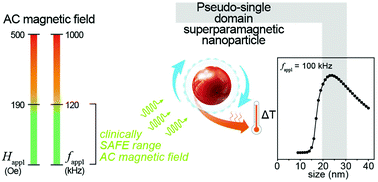Pseudo-single domain colloidal superparamagnetic nanoparticles designed at a physiologically tolerable AC magnetic field for clinically safe hyperthermia†
Abstract
Magnetic nanofluid hyperthermia (MNFH) with pure superparamagnetic nanoparticles (P-SPNPs) has drawn a huge attraction for cancer treatment modality. However, the low intrinsic loss power (ILP) and attributable degraded-biocompatibility resulting from the use of a heavy dose of P-SPNP agents as well as low heat induction efficiency in biologically safe AC magnetic field (HAC,safe) are challenging for clinical applications. Here, we report an innovatively designed pseudo-single domain-SPNP (PSD-SPNP), which has the same translational advantages as that of conventional P-SPNPs but generates significantly enhanced ILP at HAC,safe. According to the analyzed results, the optimized effective relaxation time, τeff, and magnetic out-of-phase susceptibility, χ′′, precisely determined by the particle size at the specific frequency of HAC,safe are the main reasons for the significantly enhanced ILP. Additionally, in vivo MNFH studies with colloidal PSD-SPNPs strongly demonstrated that it can be a promising agent for clinically safe MNFH application with high efficacy.



 Please wait while we load your content...
Please wait while we load your content...